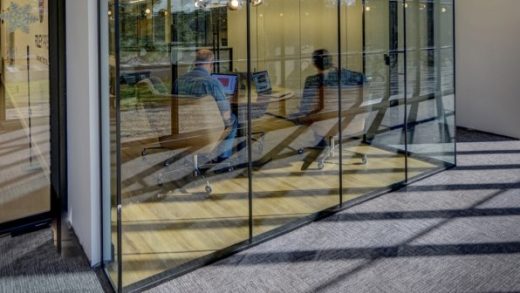Can We Create A New Kind Of Downtown In Abandoned Suburban Offices?
In the latter half of the 20th century, around 5,000 researchers and engineers went to work every day in suburban Holmdel, New Jersey, at Bell Labs, the research and design arm of AT&T. The work done in the lab became the foundation of modern electronic communication: It’s widely cited as the birthplace of the cell phone. But by the early 2000s, the communication technology that came out of the work in there had, ironically, made the workplace itself obsolete. Bell Labs’ focus on telecommunications essentially made remote work possible, and more and more employees opted to do so until the sprawling building was mostly empty. In 2007, Alcatel-Lucent, the company that had taken over Bell Labs from AT&T, shuttered operations at the 460-acre site.
For people in the town of Holmdel, the massive building threatened to become something of an albatross. Bustling with workers and producing cutting-edge innovations, Bell Labs generated around 25% of Holmdel’s taxes at its heyday–a not-insignificant figure, especially when you consider that the McMansion-filled suburb is one of New Jersey’s wealthiest enclaves. Now, it just took up space. The town of Holmdel searched for buyers, but tenants in need of 2 million square feet of space were now rare; across New Jersey and the rest of America, sprawling suburban corporate complexes were being abandoned at an alarming rate for remote work or more urban headquarters. Alcatel-Lucent was eyeing a deal with a developer who wanted to buy and demolish Bell Labs to build housing.
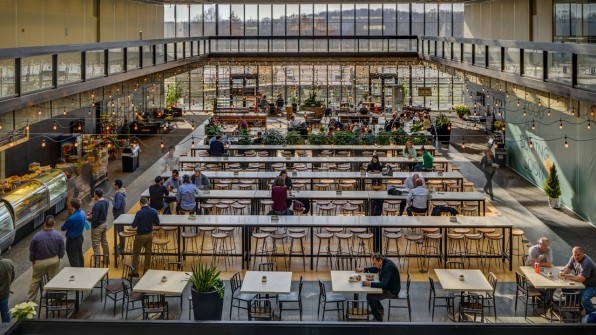
That option sparked international outcry. Eero Saarinen, the renowned midcentury modernist architect behind icons like the Gateway Arch in St. Louis, designed the Bell Labs building, which opened a year after he passed away in 1961. The mirrored panels that line the entire exterior once led the Architectural Forum to christen the complex “The Biggest Mirror Ever,” and its listed in the National Register of Historic Places for its architectural significance. Demolition wasn’t an option, so the first developer bowed out of sale.
Unable to be filled or torn down, Bell Labs seemed to taunt Holmdel. Until another developer Ralph Zucker, based in the nearby town of Lakewood, toured the building in 2008 and saw an opportunity; his company, Somerset Development, bought the property for $27 million from Alcatel-Lucent in 2013. Now he’s nearing completion of his vision: a walkable community hub smack in the middle of a quiet suburb–something he has termed a “metroburb.”
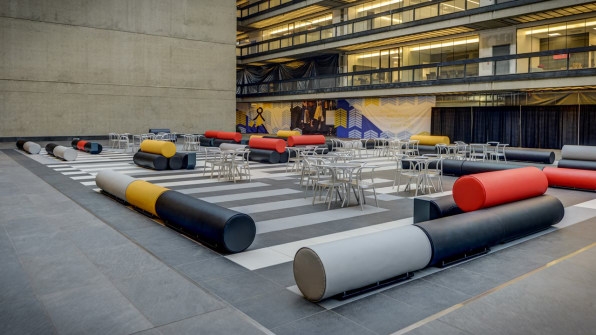
Now called Bell Works, the opaque laboratory walls of the old Bell Labs have largely been replaced with glass. Startups and companies like Santander Bank and the HR company iCIMS are set up in the office spaces on the upper floors (to access those, you need a pass to get by security, but the ground floor–the “main street” is open to the public). A sea of market-style tables line the central corridor the ground floor, which will house a food hall. The roof of the building will be transformed into a hotel; the basement into a conference center and ballroom. There’s a library and a daycare on one end of the vast hall; a fitness studio and a salon on the other. Paola Zamudio, head of the studio NPZ Style + Décor, has overseen much of the design of the public space, including what will become a small “urban park” in the right wing of the building, complete with below-lit trees an park benches.
“When I came in here first, it was cluttered with cubicles and garbage,” Zucker tells Fast Company as he stands inside the main hall, now nearly fully renovated to the tune of $200 million, and 70% leased. “You couldn’t really walk through the atrium,” he says, miming about a foot’s width of space. “But I saw pedestrian space.”
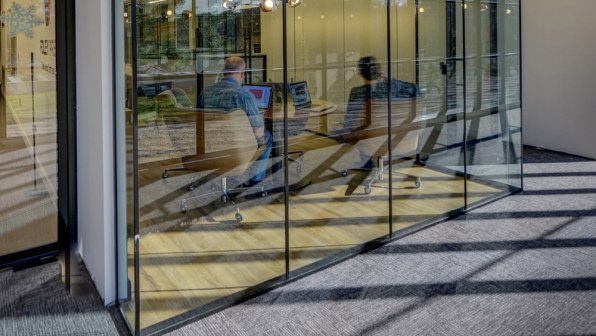
What’s missing from this attempt at downtown-style space, though, is housing. Zucker’s development plan allows for around 185 new condominiums and 40 McMansions to be built along the fringes of the property. Though he advocated for more multifamily housing to accompany Bell Works, the town’s zoning board shot him down; the suburban mind-set held sway.
As a town, Holmdel is a prime example of the sprawl that began to define the country in the mid-20th century. There’s barely any downtown; the nearest thing you might consider one is probably 10 miles away, in Asbury Park. The Garden State Parkway slices through the middle of Holmdel, and the massive homes that sit beyond shouting distance from each other are barely visible from the road. Everyone drives.
The New Urbanist movement, of which Zucker considers himself a devotee, is a reaction against sprawl that began in the 1980s and advocates for livable, walkable, amenity-rich communities. This mentality continues to shape many design proposals today (witness the concept of converting massive parking lots around transit hubs into dense communities filled with affordable homes). But it’s a hard concept to retrofit into a town made to keep people contained in their own space.
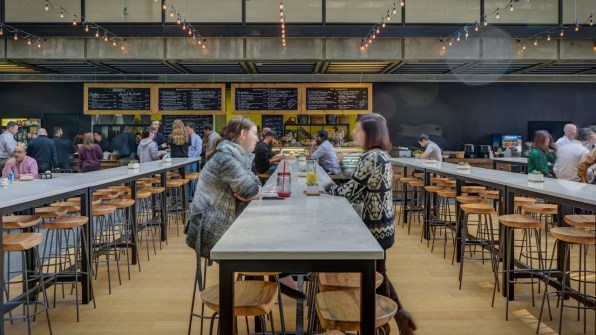
Unless, Zucker thought, the space exists to bring it to life. And Bell Labs–roughly equivalent to the Empire State Building tipped on its side–is just around the ideal size for a walkable, amenity-rich community. The hallways that line either side of the atrium on the ground floor stretch around 10 feet wide and surround open squares that mirror the dimensions of urban piazzas. They just happen to be inside.
When he first brought the plan for the metroburb to a Holmdel town hall, the response Zucker heard was, “Hell no.” People told him this was antithetical to the reason they moved to Holmdel, a sheltered, quiet place to raise their families. They didn’t want anything urban. What changed their minds, Zucker says, was an event he hosted at Bell Labs soon after touring the building in 2009: an open house wherein he projected shops and offices onto the walls of the old laboratory spaces, and hosted a pop-up gelato stand and a bar. The simulation of the space’s potential was so compelling, he says, that one woman smacked her head on a wall, thinking a projected hotel lobby was, in fact, the real thing. Still, though, it took until 2013 for Zucker to receive final approval from Holmdel for the purchase and to have the building rezoned as mixed-use; construction began not long after, and in the intervening years, Holmdel has largely embraced the development.
Perhaps that’s because, community-building impetus aside, it’s hard to see how Bell Works is something other than the next generation of the suburban mainstay: the shopping mall. While vastly more architecturally sophisticated than your standard commercial big block, Bell Works is still an enclosed space, and, though certainly walkable inside, it’s surrounded by 5,000 parking spaces. The nearest New Jersey Transit station, in Aberdeen, is around six miles away. For devotees of the New Urbanism movement, all amenities that make up a neighborhood–from transit to housing to shops, should be reachable within no more than a five-minute walk. Sure, you can, walking quickly, make it from one narrow end of Bell Works to the other, and pass a variety of storefronts. But you won’t see any apartment units inside, and the separate row of homes going up on the edge of the property don’t exactly achieve the feel of a truly integrated, human-scale neighborhood. And unless you have several hours, the train stop could never be described as “walkable.” For all intents and purposes, Bell Works is a destination, not a downtown.
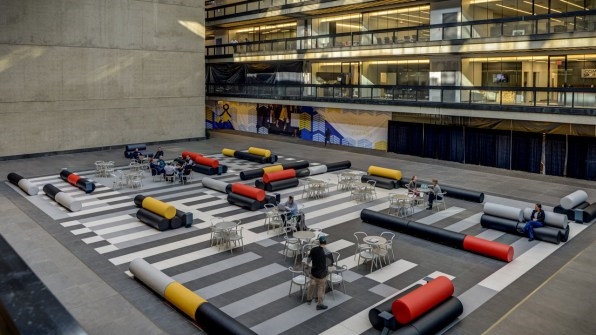
Zucker is aware of this. But he is also relentlessly optimistic that the existence of Bell Works will begin to change some of the dynamics around it. He envisions a network of shuttle buses and autonomous vehicles ferrying people between Bell Works and the train station, the constant flow of circular traffic eventually doing away with the need for acres of parking, which he imagines potentially building up into housing. Perhaps, he says, the increased flow of traffic to Bell Works could incentivize the development of a new train line through Holmdel.
With Bell Works, and the model of development it represents, Zucker is hoping to delineate the middle ground between city and suburb for millennials, many of whom are in the midst of a “reverse migration” out of urban areas. “Even if they’re in the suburbs, they’ll want an urban vibe, and a convenient, dense community,” Zucker says. “That’s the message that we communicated to our tenants–that their employees can come here and be surrounded by all of these assets and inspiration, that they’ll want to be here. This is the Googleplex for everyone.”
For people who thrive in the urban environment, for whom life is unimaginable without a robust public-transit network and towering, dense apartment buildings cheek-to-cheek with diverse retail, Bell Works will never truly fly as a urban, or “metroburban,” space. But that, perhaps, is not the best lens through which to look at the development. “Out here in the suburbs, you have two options for public spaces, the mall, or the strip mall,” Zucker says. “You can go down Route 35 and grab coffee, then get in your car and drive 15 minutes just to get across the street, find a parking spot, and go to the gym. Then you drive another 15 minutes to go to the pharmacy.” At Bell Works, Zucker adds, “all of that is going to be right here.”
And there’s a larger question that Bell Works is getting at: What is to be done with the now-defunct office parks that once drew employees out to the suburbs across America? A 2016 report found that around 22% of office inventory in five suburban markets is empty and struggling to attract new tenants; that’s up to 1 billion square feet of unused space. In a time when the country is struggling with both housing volume and affordability, and when it’s becoming ever more clear that the type of suburban sprawl that necessitates driving between basic amenities is counterproductive in the face of fighting climate change, we need to be thinking more proactively about how best to use these massive, abandoned lots. Homes are being built around Bell Works, but Zucker hopes to see more: Perhaps, if developers begin to eye abandoned campuses like the Roche facility in Nutley, 10 miles west of midtown Manhattan, for similar projects, a connected network of these “metroburbs” could start to materialize.
It’s a long way off and an ambitious vision, but Zucker is undeterred. If Bell Works can act as an agent for pulling sprawling suburban New Jersey together, it’ll be something other parts of the U.S. should start watching closely. The principles of building a new community mandate that it be a place where people can, and want to go; it should feel a part of something, not a secluded enclave in the midst of a disjointed landscape.
Fast Company , Read Full Story
(56)

